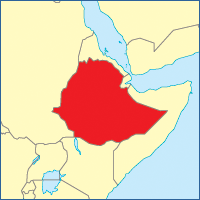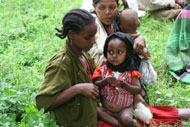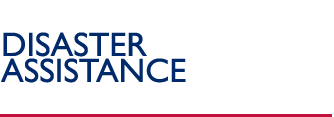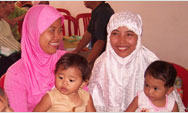 |
Ethiopia |
Disaster Assistance at a Glance
Recent Disaster Declarations:
Complex Emergency, Complex Emergency (Somali Region), and Floods
OFDA Response:
Agriculture
and food security, emergency relief
supplies, health, humanitarian
coordination and information management,
livelihoods, logistics, nutrition,
water, sanitation, and hygiene
OFDA Preparedness:
Seed multiplication, flood mitigation, climate forecasting
Latest OFDA Report:
Ethiopia Situation Report #6 (60kb PDF)
|

|
|
|
Complex Emergency, 10-15-2007
Cyclical droughts, exacerbated by a rapidly growing population, endemic poverty, and limited government capacity, have led to chronic food insecurity and water shortages in Ethiopia. Despite an overall improvement in food security in 2007, approximately 8 million people in Ethiopia continue to receive food assistance through the productive safety net program (PSNP), and an additional 1 million people will likely require assistance in 2008. Significant humanitarian challenges, including flooding, conflict, malnutrition, acute watery diarrhea outbreaks, delayed food response, restrictions on trade and movement, and locust infestations, confront populations in many areas of the country. These challenges have also contributed to projected emergency needs for 2008.
On October 15, U.S. Ambassador Donald Y. Yamamoto reissued a disaster declaration in response to the ongoing complex emergency in Ethiopia. In FY 2007, USAID/OFDA provided more than $12.4 million to 15 implementing partners for humanitarian interventions in Ethiopia. In FY 2008, USAID/OFDA continues to support a wide range of relief programming, including in the health, nutrition, agriculture and food security, economy and market systems, logistics and relief commodities, humanitarian coordination and information management, risk reduction, and water, sanitation, and hygiene sectors.
Complex Emergency (Somali Region), 08-16-2007
Despite good rains in the Somali Region of Ethiopia in late 2006, the cumulative impact of a decade of drought, intermittent civil conflict, high rates of malnutrition, steadily increasing food prices, flooding, and Rift Valley fever exhausted the coping mechanisms of pastoralists and agro-pastoralists, increasing vulnerability to famine and destitution through the loss of livelihoods. In addition, the Government of the Federal Democratic Republic of Ethiopia military operations and bureaucratic reorganizations restricted commercial trade, delayed food distributions, and limited movement of pastoralists and their livestock. Ogaden National Liberation Front targeted harassment of civilians and relief staff also negatively affected the humanitarian situation.
On August 16, 2007, U.S. Ambassador Donald Y. Yamamoto declared a disaster
due to the complex emergency in Ethiopia’s Somali Region. From FY 1990
to FY 2006, USAID/OFDA provided more than $158.6 million to Ethiopia in response
to complex emergency, displacement, drought, floods, food insecurity, food
shortages, a health emergency, a locust infestation, and a volcano. In FY 2007,
USAID/OFDA provided more than $12.7 million for humanitarian assistance in
Ethiopia, of which more than $3.7 million was allocated to Somali Region to
support programs in health and nutrition, agriculture and food security, and
water, sanitation, and hygiene, as well as livelihood activities and emergency
relief commodities.
Floods, 11-07-2006
 |
A woman feeds her malnourished daughter at a community feeding program in Ethiopia. |
Unusually heavy rainfall in October and November 2006 caused widespread flooding in Somali Region, Ethiopia. According to the U.N., flooding affected an estimated 362,000 people, killed 80 others, and displaced 122,500 residents. The most-affected zones included Gode, Afder, Liben, and Korahe, where OCHA reported an increased incidence of acute watery diarrhea, malaria, and intestinal parasites due to stagnant water and widespread damage to sanitation facilities. In addition, damage to irrigation canals in west Gode Zone disrupted agricultural activities, raising additional concerns about longer-term food security.
On November 7, U.S. Chargé d'Affaires Vicki J. Huddleston declared a disaster due to the effects of the flooding in Somali Region. Through a standing agreement with the U.N. World Food Program (WFP), OFDA approved the use of $467,290 in rapid response funds for emergency air operations to assist flood victims in Ethiopia. In addition, OFDA worked closely with partner International Rescue Committee (IRC) and the Combined Joint Task Force-Horn of Africa (CJTF-HOA) to coordinate the airlift of emergency relief commodities to Gode Zone in Somali Region.
For information on additional USAID disaster responses in Ethiopia, please see OFDA Annual Reports.
Back to Top ^
|


